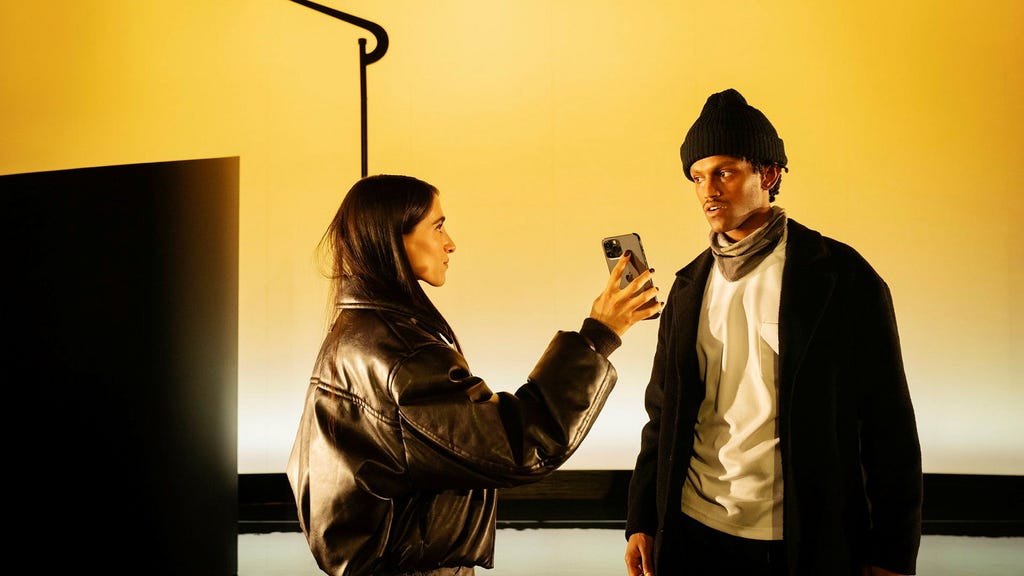Bereket Hailemariam’s ”Teorier om människan” (Theories of Man), directed by Lars Melin at Backa Teater, is a profound exploration of communication, connection, and the inherent limitations of language. The play, originally commissioned by Barnteaterakademin in Gothenburg, showcases the burgeoning talent of a playwright with a keen eye for the complexities of human interaction. Melin’s direction masterfully weaves together the philosophical threads of the text with the vibrant energy of a young, talented ensemble, creating a theatrical experience that is both intellectually stimulating and emotionally resonant. The production shines a light on the often-unseen struggles of young people navigating the labyrinthine world of relationships and self-discovery in the digital age.
The play centers around three sixteen-year-old friends, Josef, Hermon, and Sami, whose interactions reveal the chasm between spoken words and true understanding. Their attempts at communication, while constant, often circle around each other, failing to truly connect. Josefin Hinders’ set design, a stark yet futuristic urban landscape, mirrors this sense of disconnect. The black, polished floor, reminiscent of wet asphalt, and the crooked streetlights create an atmosphere of alienation, reflecting the internal landscapes of the characters. The cyclical nature of their conversations, represented by the characters riding bicycles in circles, emphasizes the repetitive and often futile nature of their attempts to bridge the gaps between them.
Each character embodies a different facet of this communication breakdown. Josef, portrayed with exuberant energy by Nikola Borggård Gavanozov, is consumed by the intoxicating rush of new love, incessantly recounting his text message exchanges, oblivious to his friends’ lack of engagement. Hermon, played by Sharzad Rahmani, desperately tries to maintain the cohesion of the group, driven by a deep-seated fear of loneliness. Meanwhile, Sami, played by Yohannes Frezgi, struggles with a relentless inner critic, a Siri-like voice that constantly reinforces his feelings of inadequacy and isolation, creating a self-fulfilling prophecy of social ineptitude. Their individual struggles intertwine, highlighting the universal human need for genuine connection and the challenges of achieving it in a world increasingly mediated by technology.
The play’s brilliance lies not only in its insightful portrayal of teenage anxieties but also in its exploration of the very nature of language itself. Hailemariam’s script, brimming with witty dialogue and philosophical musings, delves into the paradox of words: their simultaneous power and impotence. While language serves as the primary means of connection, it also reveals its inherent limitations in conveying the complexities of human emotions and experiences. This thematic tension is palpable throughout the performance, adding layers of meaning to the seemingly mundane interactions of the characters. The characters’ constant talking, despite its superficiality, underlines their desperate yearning for genuine connection – a quest that transcends the very words they use.
A pivotal moment in the performance occurs when the scene shifts to reveal a smaller stage with blacked-out instruments. This scene, initially promising music, instead underscores the characters’ inability to connect even through artistic expression. However, Yohannes Frezgi’s subsequent monologue about jazz saxophonist John Coltrane, a master of translating emotions into music, elevates the performance to a new level. Frezgi’s captivating presence and powerful delivery transfix the audience, momentarily bridging the divide between performer and spectator, echoing Coltrane’s ability to transcend the limitations of language through art. This scene underscores the play’s central message: that despite the inherent limitations of words, genuine human connection remains a possibility, sometimes achieved through unexpected avenues.
”Teorier om människan” is a testament to the power of theatre to explore complex themes through compelling storytelling. The performances of the three young actors are nothing short of remarkable, capturing the nuances of teenage angst and the yearning for connection with authenticity and raw energy. The play’s exploration of communication, loneliness, and the search for meaning resonates deeply, offering a poignant reflection on the human condition in the digital age. It is a play that lingers in the mind long after the curtain closes, prompting reflection on the power and limitations of language, and the enduring human need for connection. The production is a must-see, not only for its insightful script and skilled direction but also for the remarkable performances of its young cast, who embody the complexities of their characters with remarkable depth and sensitivity.














